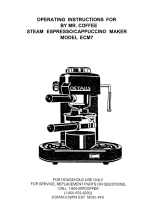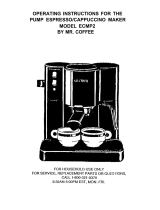
How to Make Cappuccino
(continued)
2.
3.
4.
5.
6.
7.
8.
9.
9
For 2 servings, fill with water to the midpoint between the 2 and 4 cup markings.
l
For 4 servings, fill with water up to the bottom of the metal band.
Follow steps
1
-
3 in “Brewing Espresso” on page 7.
Fill a small stainless steel or ceramic pitcher full with cold
milk
and set next to
machine. Skim milk or 2% will be the easiest to froth.
Rotate the selector control knob to the “cup” marking. The espresso will
begin
to flow
in about three minutes. As soon as the espresso reaches the steaming
symbol
on
the
glass carafe, turn the selector control knob to the OFF position. At that time the boiler
has created enough pressure and steam to start frothing the milk. Frothing the milk
before finishing the espresso prevents you from running out of
steam. This can happen if you froth towards the end of the
brewing process.
Hold the pitcher under the frothing tube so that the frothing aid
is slightly immersed in the milk. Turn the selector control knob
slowly to the “steam” position. Gently move the pitcher in a
circular motion around the steam nozzle. The amount of steam
pressure for frothing milk can be regulated in four positions. To
change amount of pressure rotate, the selector control knob
toward you, past the “steam” position. Because warm milk does
not froth, the milk should be frothed from just below the surface.
See figure 4.
When the milk has doubled in volume, or reached 100 F on your
Figure 4
beverage thermometer (if,you own a thermometer), insert the frothing aid deeper into
the milk to further heat the milk. To avoid splattering of hot milk, do not let the frothing
aid go above the surface of the milk until the selector control knob is
OFF
This is done
by rotating the selector control knob back to the OFF position. After the milk is frothed
set the pitcher aside and allow the frothed milk to settle. Turn the selector control knob
back to the “cup” position to finish making espresso.
When the espresso has stopped flowing into the carafe, turn the selector control knob
to OFF. Pour the espresso into a cup which has the capacity of at least 5 ounces. Then
add the steamed milk to the espresso and spoon on the frothed milk. The proportion
between espresso and milk is to taste; in Italy it is normally
1
part espresso, 1 part
steamed milk, plus 1 part froth.
Follow the instructions on page 3 under section marked
“CAUTION: PRESSURE”
to
flush out any residual milk from the frothing tube and frothing aid.
Unplug the power cord and allow the machine too cool.
Do not remove boiler cap
until the pressure in the machine has been released.
Follow procedures in section
marked
“CAUTION: PRESSURE”
on page 3.
CAUTION:
Do not remove filter holder at anv time while the machine is under
p
essure
or until the machine has cooled down. Follow the procedures marked
caution
PRESSURE”
on page 3 to relieve the pressure before removing the filter holder and
1
brew basket.
10.
Continue to follow steps 7
-
8 in “Brewing Espresso” on page 7.























